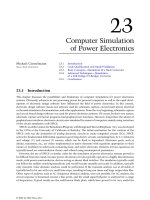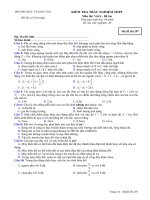Electronic Spectroscopy 1 docx
Bạn đang xem bản rút gọn của tài liệu. Xem và tải ngay bản đầy đủ của tài liệu tại đây (6.67 MB, 22 trang )
1
Optical Electronic Spectroscopy 1
Lecture Date: January 23
rd
, 2008
The Electromagnetic Spectrum
UV-Visible
X-ray
2
What is Electronic Spectroscopy?
Spectroscopy of the electrons surrounding an atom or a
molecule: electron energy-level transitions
Atoms: electrons are in
hydrogen-like orbitals
(s, p, d, f)
Molecules: electrons are in
molecular orbitals (HOMO,
LUMO, …)
(The LUMO of benzene)
(The Bohr model for nitrogen)
From
Optical Electronic Spectroscopy
Definition: Spectroscopy in the optical (UV-Visible) range
involving electronic energy levels excited by
electromagnetic radiation (often valence electrons).
This lecture is related to the “high-energy” (“non-optical”)
electron spectroscopy covered in the X-ray lecture
Methods:
– Atomic absorption
– Atomic emission (e.g ICP-OES)
– Molecular UV-Visible absorption
– Luminescence, Fluorescence, Phosphorescence
3
Definitions of Electronic Processes
Emission: radiation produced by excited molecules, ions,
or atoms as they relax to lower energy levels.
Absorption: radiation selectively absorbed by molecules,
ions, or atoms, accompanied by their excitation (or
promotion) to a more energetic state.
Luminescence: radiation produced by a chemical
reaction or internal electronic process, possibly following
absorption.
More Electronic Processes
Fluorescence: absorption of radiation to an excited state,
followed by emission of radiation to a lower state of the
same multiplicity
– Occurs about 10
-5
to 10
-8
seconds after photon absorption
Phosphorescence: absorption of radiation to an excited
state, followed by emission of radiation to a lower state of
different multiplicity
– Occurs about 10 to 10
-5
seconds after photon absorption
4
What is Emission?
Atoms/molecules are driven to excited states (in this case
electronic states), which can relax by emission of
radiation.
M + heat M*
Other process can be active, such as “non-radiative”
relaxation (e.g. transfer of energy by random collisions).
M* M + heat
E = hn
Higher energy
Lower energy
OES = Optical Emission Spectroscopy
What is Absorption?
Electromagnetic radiation travels fastest in a vacuum.
– When EM radiation travels through a substance, it can be slowed
by propagation “interactions” that do not cause frequency
(energy) changes:
Absorption does involve frequency/energy changes, since
the energy of EM radiation is transferred to a substance,
usually at specific frequencies corresponding to natural
atomic or molecular energies
– Absorption occurring at optical frequencies involves low to mid-
energy electronic transitions.
i
i
c
n
c = the speed of light (~3.00 x 10
8
m/s)
i
= the velocity of the radiation in the medium in m/s
n
i
= the refractive index at the frequency i
5
Absorption and Transmission
Transmittance:
T = P/P
0
b
P
0
P
Absorbance:
A = -log
10
T = log
10
P
0
/P
A is linear vs. b!
(A preferred over T)
Graphs from />The Beer-Lambert Law
The Beer-Lambert Law (a.k.a. Beer’s Law):
A = ebc
Where the absorbance A has no units, since A = log
10
P
0
/ P
e is the molar absorbtivity with units of L mol
-1
cm
-1
b is the path length of the sample in cm
c is the concentration of the compound in solution, expressed in mol L
-1
(or M,
molarity)
Beer’s law can be derived from a model that considers
infinitesimal portions of a “block” absorbing photons in
their cross-sections, and integration over the entire block
– Beer’s law is derived under the assumption that the fraction of the
light absorbed by each thin cross-section of solution is the same
– See pp. 302-303 of Skoog, et al. for details
6
Deviations From the Beer-Lambert Law
Deviations from Beer’s law (i.e. deviations from the
linearity of absorbance vs. concentration):
– Intermolecular interactions at higher concentrations
– Chemical reactions (species having different spectra)
– Peak width/polychromatic radiation
Beer’s law is only strictly valid with single-frequency radiation
Not significant if the bandwidth of the monochromator is less
than 1/10 of the half-width of the absorption peak at half-
height.
For an alternative view, see: Bare, William D. A More Pedagogically Sound Treatment of Beer's Law:
A Derivation Based on a Corpuscular-Probability Model, J. Chem. Educ. 2000,77, 929.
Deviations from the Beer-Lambert Law
Intermolecular interactions at higher concentrations:
Figure from Chapter 5 of Cazes, Analytical Instrumentation Handbook 3
rd
Ed. Marcel-Dekker 2005.
Dimers,
oligomers
7
Deviations from the Beer-Lambert Law
Deviations caused by use of polychromatic light on a
spectrum in which e changes a lot over the bandwidth of
the light.
Consider two wavelengths a and b with
a
and
b
= 1500, 500
0.2
0.4
0.6
0.8
1
0.2
0.4
0.6
0.8
1
= 1750, 250
Concentration (M)
Absorbance (A)
bcbbca
ba
ba
ba
PP
PP
A
1010
log
00
00
= 1000, 1000
Basic Instrument Layout for
Optical Spectroscopy
Absorption:
Radiation
Source
Sample
Wavelength
Selector
Detector
(photoelectric transducer)
Fluorescence, Phosphorescence and Scattering:
Sample
Wavelength
Selector
Detector
(photoelectric transducer)
Radiation
source
Emission and chemi-luminescence
Sample
(source)
Wavelength
Selector
Detector
(photoelectric transducer)
(90° angle)
8
Atomization: The Dividing Line for Atomic/Molecular
Samples used in optical
atomic (elemental)
spectroscopy are usually
atomized
This destroys molecules (if
present) and leaves the
atoms
The UV-visible spectrum of
the atoms is of interest, not
the molecular spectrum.
Elemental Analysis
Elemental analysis – qualitative or quantitative
determination of the elemental composition of a sample
Optical electronic methods are heavily used in elemental
analysis
Other elemental analysis methods not discussed here:
– Mass spectrometry (MS), e.g. ICP-MS
– X-ray methods
– Other methods (radiochemical)
– Classical
9
Atomic Electronic Energy Levels
Electronic energy level
transitions in hydrogen
– the simplest of all!
Balmer series (visible)
– Transitions start
(absorption) or end
(emission) with the first
excited state of
hydrogen
Lyman series (UV)
– Transitions start
(absorption) or end
(emission) with the
ground state of
hydrogen
Diagrams from />Atomic Electronic Energy Levels
Used to denote
energy levels, and
label term (Grotrian)
diagrams for the
hydrogen atom
Figure from the Sapphire Electronic Spectroscopy Software Package, Cavendish Instruments Limited.
Term symbols and electronic
states: used to precisely define
the state of electrons
2
P
3/2
s,p,d,f,g
(l value)
2
P
3/2
-1/2
j
m
j
s
l
12
spin
multiplicity
2j+1
s = total spin quantum number
j = total angular momentum quantum number
l = orbital quantum number (s,p,d,f…)
m
j
= state
2
PTerm:
Level:
State:
10
Atomic Electronic Energy Levels
Term symbol (Grotrian)
diagram for the sodium atom
Each transition on the
diagram can be linked to a
peak in the spectrum
The number of lines can
approach 5000 for transition-
metal elements.
Line broadening can be
caused by:
– Doppler effects
– pressure broadening
(collisions)
– Lifetime of state (uncertainty)
Figure from H. A. Strobel and W. R Heineman, Chemical
Instrumentation: A Systematic Approach, Wiley, 1989.
Atomic Electronic Energy Levels
The population of energy levels partly determines the
intensity of an emission peak
The Boltzmann distribution relates the energy difference
between the levels, temperature, and population:
kT
EE
P
P
N
N
groundexcited
ground
excited
ground
excited
exp
E = energy of state
P = number of states having equal energy at each level
N = number of atoms in state
Key point: to get more atoms into excited states, you need
higher temperatures. (See example 8-2, problem 8-9)
Element/Line (nm) N
e
/N
g
at 2000 K N
e
/N
g
at 3000 K N
e
/N
g
at 10000
K
Na 589.0 9.9 x 10
-6
5.9 x 10
-4
2.6 x 10
-1
Ca 422.7 1.2 x 10
-7
3.7 x 10
-5
1.0 x 10
-2
Zn 213.8 7.3 x 10
-15
5.4 x 10
-10
3.6 x 10
-3
(Values from Cazes pg 79, Table 1)
11
Atomic Electronic Energy Levels
0 5000 10000 15000 20000
0
20000
40000
60000
80000
100000
Wavelength / nm
Intensity / Arbitrary Units
The simulated spectrum for the sodium atom
Atomic Emission
Two types of emission spectra:
– Continuum
– Line spectra
Examples:
– ICP-OES (inductively-coupled
plasma optical emission
spectroscopy), also known as ICP-
AES
– LIBS (laser-induced breakdown
spectroscopy)
12
Torches and Atomic Emission
History: Emission came first (study of sunlight by Fraunhofer in
1817, identification of spectral “lines”), studied throughout the
1800’s and early 1900’s
Atomizer/
Emission Source
Temperature
(°C)
Flame 1700-3150
Plasma (e.g.
ICP)
4000-8000
Electric arc 4000-5000
Electric spark >10000
Before the use of the plasma for
OES in 1964, the flame/gas torch (or
arc/spark, etc…) had the following
problems:
– Temperature instability
– Not hot enough to excite/decompose
all materials
Today: The plasma has become the almost universally-
preferred method
History: atomic emission placed demands on monochromators
Today: Technology has led to polychromators/detectors with
sufficient resolution
Plasma Torches
Plasma: a low-density gas
containing ions and electrons,
controlled by EM forces
13
Plasma Torches
In the inductively-coupled
plasma (ICP) torch, the
sample will reside for
several milliseconds at
4000-8000K.
Other torches – direct
current plasma
Microwave induced plasma
Photo by Steve Kvech, /> An argon ICP torch in action:
More on Plasma Torches
Diagram from Lagalante, Appl. Spect. Reviews. 34, 191 (1999)
Another view of an argon ICP torch:
14
Arc and Spark Sources for Atomic Emission
Arc and spark sources – used for qualitative analysis of
organic and geological samples
– Only semi-quantitative because of source instability
– Spark sources achieve higher energies
Several mg of solid sample is packed between
electrodes, 1-30 A of current is passed achieving
several hundred volts potential.
Applications include metals analysis or cases where
solids must be analyzed.
Atomic Emission: Mono- and Polychromators
Diffraction gratings are used
to select wavelengths (in
combination with collimating
lens, and slits)
Echelle (ladder) gratings:
high dispersion and high
resolution
– ~1000-1500 grooves/mm
typical for UV-Vis work
– Require filters to isolate
“orders” (i.e. n=1)
m = d(sin i + sin r)
15
Atomic Emission: Detectors
At the end of the spectrometer, photons are detected.
Commonly used detectors:
– Photomultiplier tubes (PMT) – dynamic range 10
9
– Solid-state detectors:
Charge-coupled devices (CCD) – 1D or 2D arrays
(charge readout or “transfer” devices)
Silicon photodiodes with thousands of individual
elements
Very sensitive, very well-suited to echelle grating
polychromators, very fast
Modern ICP-OES Spectrometers
Example system:
Varian Vista PRO
Features:
1. Axial flame view
2. Echelle grating
polychromator
3. CCD detector
CCD chips are
often made of sub-
arrays matched to
emission lines.
Figure from Varian Vista PRO sales literature.
16
Detection Limits of ICP-OES
Typical detection limits
(Varian Vista MPX):
Considerations include
the number of emission
lines, spectral overlap
Linearity can span
several orders of
magnitude.
See also Figure 10-13 in
Skoog, et al.
Element Wavelength (nm)
Detection Limit
axial (ug/L)
Detection limit
radial (ug/L)
Ag 328.068 0.5 1
Al 396.152 0.9 4
As 188.98 3 12
As 193.696 4 11
Ba 233.527 0.1 0.7
Ba 455.403 0.03 0.15
Ba 455.403 0.03 0.15
Be 313.107 0.05 0.15
Ca 396.847 0.01 0.3
Ca 317.933 0.8 6.5
Cd 214.439 0.2 0.5
Co 238.892 0.4 1.2
Cr 267.716 0.5 1
Cu 327.395 0.9 1.5
Fe 238.204 0.3 0.9
K 766.491 0.3 4
Li 670.783 0.06 1
Mg 279.55 0.05 0.1
Mg 279.8 1.5 10
Mn 257.61 0.1 0.133
Mo 202.03 0.5 2
Na 589.59 0.2 1.5
Ni 231.6 0.7 2.1
P 177.43 4 25
Pb 220.35 1.5 8
Rb 780.03 1 5
S 181.972 4 13
Sb 206.83 3 16
Se 196.03 4 16
Sr 407.77 0.02 0.1
Sn 189.93 2 8
Ti 336.12 0.5 1
Tl 190.79 2 13
V 292.4 0.7 2
Zn 213.86 0.2 0.8
Atomic Absorption – Early History
In the beginning – atomic emission was the only way to
do elemental analysis via optical spectroscopy
Bunsen and Kirchhoff (1861) – invented a non-luminous
flame to study emission. Showed that alkali elements in
the flame removed lines from a continuous source.
Walsh (1955) – notices that molecular spectra are often
obtained in absorption (e.g. UV-Vis and IR), but atomic
spectra are always obtained in emission. Proposes to
use atomic absorption (AA or AAS) for elemental analysis
– Advantages over emission – far less interference, avoids
problems with flame temperature
17
Atomic Absorption (AA) and Elemental Analysis
Atomic absorption spectrometry
is one of the most widely used
methods for elemental analysis.
Basic principles of AA:
– The sample is atomized via:
A flame (methane/H
2
/acetylene
and air/oxygen)
An electrothermal atomizer (an
electrically-heated graphite tube
or cup)
– UV-Visible light is projected
through the flame
– The atoms absorb light (electronic
excitation), reducing the beam
– The difference in intensity is
measured by the spectrometer
Source
Detector
Sample/Flame
Monochromator
P
0
P
Images are of Aurora AI1200,
Atomic Absorption: Sources
Hollow cathode lamps – sputtering of an element of
interest, generating a line emission spectrum:
Typical linewidths of 0.002 nm (0.02Å)
Other AA Sources: electrode-less discharge lamp (EDL) –
see Skoog Ch 9B-1
18
Atomic Absorption: Monochromators
The monochromator filters out undesired light in AA
(typical bandwidths are 1 angstrom/0.1 nm)
Unlike ICP-OES, where the mono- or polychromator
actually analyzes the frequency.
– In other words – there is no need to scan the grating, just set
(aimed through a slit) and run
Echelle (ladder) gratings are popular:
Figure from T. Wang, in J. Cazes, ed, “Ewing’s Analytical Instrumentation Handbook”
Other Features of Atomic Absorption Systems
Sample nebulizers: Produces aerosols of samples to
introduce into the flame (oxyacetylene is the hottest)
Detectors: Common examples are photomultiplier tubes,
CCD (charge-coupled devices), and many more.
Monochromator: removes emissions from the flame
(flame is often kept cool just to avoid emission)
Modulated source (chopper): also removes the remaining
emissions from the flame. The signal of interest is given
an AC modulation and passed through a high-pass filter.
Spectral interferences:
– Absorption from other things (besides the element of interest) –
other flame components, particulates, etc… Scattering can
cause similar problems
– Background correction can help
19
Detection Limits of Atomic Absorption Systems
How Are Elements Actually Analyzed?
For AA and ICP-OES, samples are dissolved or digested
into solution.
Samples are flowed into the flame/plasma and analyzed.
Two methods for quantitative analysis:
– Standard calibration: the unknown sample’s
absorbance/emission is compared with several references which
“bracket” the expected concentration. (Linear relationship)
– Standard addition: the unknown sample is divided into several
portions. One portion is directly analyzed, the others have the
reference material added in varying amounts. The linear
relationship is determined, and the intercept is used to calculate
the real concentration of the unknown
At the end: the results yield elements in ppm, ppb,
mg/mL, etc…
20
Atomic Fluorescence
Developed as an alternative to AA and ICP-OES, with
potentially greater sensitivity.
– Has not yet achieved widespread use but cheaper tunable lasers
may change this.
Laser – stimulated emission (coherent emission from an
excited state induced by a second photon)
Processes:
Resonance
Direct Line
hv
hv
Non-radiative
Stepwise Thermally-assisted
Non-radiative
hv
Thermal
hv
Atomic Fluorescence
Instrumentation
Sample
Wavelength
Selector
Detector
(photoelectric transducer)
Radiation
source
(90° angle)
Sources include hollow-
cathode lamps,
electrodeless discharge
tubes (brighter), and lasers
(brightest)
Picture from Perkin-Elmer
21
Laser-Induced Breakdown Spectroscopy (LIBS)
Just like ICP-OES, except a focussed laser creates the
plasma:
Figure from US Army/Ames
Fiber optic
Elemental Analysis with Optical Spectroscopy
A comparison of the techniques – the choice is not always clear!
Plasma Emission
(ICP-OES)
AA (Flame) Atomic
Fluorescence
Dynamic Range Wide Limited Wide
Qualitative Analysis Good Poor Poor
Multielement Scan? Good Poor Poor
Trace Analysis Good Good Good
Small samples Good Good Good
Matrix interferences Low High Low
Spectral
interferences
High Low Low
Cost Moderate Low Moderate
Speciated analysis: The analysis of atomic “species”, elements in
chemically distinguishable environments.
Examples of hyphenation to add “speciation”:
– ICP-OES coupled to a HPLC
– AA coupled to a GC
22
Homework Problems
Optical Electronic Spectroscopy
Chapter 8:
Problem 8-9
Chapter 10:
Problem 10-2
Further Reading
Review Skoog et al. Chapters 6-10
Review Cazes Chapters 3-4
Optical Electronic Spectroscopy
H. A. Strobel and W. R. Heineman, “Chemical
Instrumentation: A Systematic Approach”, 3
rd
Ed.,
Wiley (1989).









